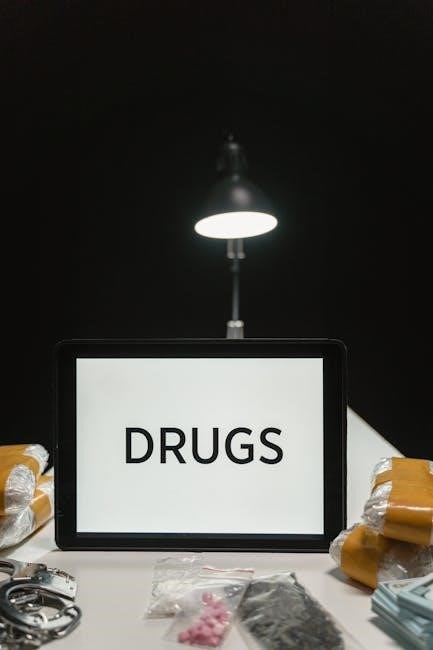A controlled substance agreement is a formal contract between patients and healthcare providers, outlining the safe use and handling of controlled substances. It ensures compliance with DEA regulations, specifies patient-provider responsibilities, establishes goals and risks, and prevents misuse, ensuring responsible treatment.
1.1 Definition of Controlled Substances
Controlled substances are drugs or chemicals regulated by the government due to their potential for abuse and dependence. They are classified into schedules based on their medical use and abuse potential. Examples include opioids, stimulants, and depressants. These substances require special handling and monitoring to prevent misuse. The Controlled Substances Act oversees their distribution, and healthcare providers must adhere to strict guidelines when prescribing them. Understanding this definition is crucial for establishing agreements that ensure safe and legal use of these medications.
1.2 Importance of Controlled Substance Agreements
Controlled substance agreements are essential for preventing misuse and ensuring compliance with legal regulations. They establish clear guidelines for patients and providers, outlining responsibilities and expectations. These agreements help minimize the risk of diversion and addiction by monitoring use and adherence to treatment plans. By setting boundaries and consequences, they promote accountability and safe prescribing practices. Ultimately, such agreements protect both patients and providers while fostering a framework for responsible medication management. They are a critical tool in balancing the therapeutic benefits of controlled substances with their potential risks.

Legal Framework Governing Controlled Substances
Controlled substances are governed by strict federal and state laws, enforced by the DEA, to prevent misuse, diversion, and ensure compliance with safe prescribing practices.
2.1 Role of the Drug Enforcement Agency (DEA)
The DEA plays a crucial role in regulating controlled substances by enforcing federal laws, classifying drugs based on their potential for abuse, and ensuring compliance with prescribing practices. It monitors the distribution of controlled substances to prevent diversion and misuse. The DEA also sets standards for healthcare providers, requiring them to register and follow strict guidelines when prescribing controlled substances. This oversight ensures that controlled substances are used legally and safely, upholding public health and safety. The DEA’s efforts are central to combating substance abuse and maintaining accountability in healthcare.
2.2 State and Federal Regulations
Controlled substances are regulated through both state and federal laws, creating a dual framework to ensure safe use and distribution. Federal regulations, such as the Controlled Substances Act (CSA), classify drugs into schedules based on their abuse potential and medical value. State laws often mirror federal rules but may impose additional restrictions or requirements. Together, these regulations establish strict guidelines for prescribing, dispensing, and monitoring controlled substances. Compliance with both levels is essential to prevent misuse and diversion, ensuring public safety and upholding legal standards in healthcare.

Key Components of a Controlled Substance Agreement
A controlled substance agreement outlines patient and provider responsibilities, goals, and risks of treatment, establishing rules to prevent misuse and ensure safe use of medications.
3.1 Patient and Provider Responsibilities
A controlled substance agreement defines the roles and obligations of both patients and providers. Patients must use medications as prescribed, attend follow-up appointments, and notify their provider of any other controlled substances they are taking. Providers are responsible for prescribing appropriately, monitoring usage, and educating patients about risks and side effects. Both parties agree to adhere to the terms to ensure safe and effective treatment, preventing misuse and diversion. This mutual accountability is essential for maintaining trust and compliance in controlled substance therapy.
3.2 Goals and Risks of Controlled Substance Use
The primary goal of controlled substance use is to manage medical conditions effectively while minimizing risks. These medications can alleviate pain, reduce anxiety, or treat other chronic conditions. However, risks include dependence, tolerance, and potential for misuse. Patients must be aware of side effects, such as drowsiness or respiratory issues, and understand the consequences of non-compliance. By balancing benefits and risks, the agreement ensures responsible use, safeguarding both patient health and public safety through clear guidelines and monitoring. Open communication between patient and provider is crucial to address concerns promptly.
Prescribing Guidelines for Controlled Substances
Prescribing controlled substances requires adherence to strict DEA regulations, emphasizing medical necessity, clear documentation, and a personalized treatment plan to ensure patient safety and compliance.
4.1 Rules for Prescribing Opioid Analgesics
Prescribing opioid analgesics requires adherence to strict guidelines to ensure safe and responsible use. Providers must conduct thorough patient assessments, documenting medical necessity and potential risks. Patients must be educated on the dangers of misuse, overdose, and diversion. Dosage and duration should align with evidence-based practices, avoiding excessive quantities. Regular monitoring, including urine screens and prescription drug monitoring programs (PDMPs), is essential. Providers must also assess for signs of addiction or abuse, with clear protocols for addressing violations. Patient compliance with the agreement is mandatory to continue treatment.

4.2 Consequences of Misuse
Misuse of controlled substances, such as opioids, can lead to severe legal, health, and treatment-related consequences. Patients who violate agreements may face legal penalties, including fines or imprisonment. Misuse can result in overdose, addiction, or long-term health complications. Providers may terminate treatment and revoke prescription privileges. Violations of the agreement can also lead to mandatory rehabilitation programs. Patients who divert medications or obtain controlled substances from multiple sources risk losing access to future prescriptions. These consequences emphasize the importance of adhering to the terms outlined in the controlled substance agreement. Compliance is essential for continued care.

Patient-Provider Agreement Terms
This section outlines mutual responsibilities, including patient consent to monitoring, restrictions on obtaining controlled substances, and consequences for misuse. It ensures adherence to treatment guidelines and safety protocols.
5.1 Consent to Monitoring and Testing
Patients must consent to regular monitoring and testing to ensure adherence to the controlled substance agreement. This includes urine drug screens, pill counts, and medical reviews. Providers may request random or scheduled tests to verify proper use and detect diversion or misuse. Patients agree to cooperate fully with these measures, understanding that refusal or failure to comply may result in treatment termination or further action. This mutual agreement ensures safety, accountability, and responsible use of controlled substances, aligning with legal and ethical standards.
5.2 Restrictions on Obtaining Controlled Substances
Patients agree to obtain controlled substances solely from the designated provider and pharmacy. They must not seek prescriptions from multiple providers or fill prescriptions at more than one pharmacy. Sharing, selling, or transferring medications is strictly prohibited. Violations may lead to termination of treatment or legal action. Patients must notify their provider of any changes in pharmacy or provider and ensure all controlled substances are used as prescribed. This ensures accountability and reduces the risk of misuse or diversion of controlled substances.

Special Considerations for Controlled Substance Use
This section addresses unique challenges, such as handling violations of the agreement and ensuring patient education on risks and proper usage of controlled substances.
6.1 Handling Violations of the Agreement
Violations of a controlled substance agreement may result in termination of treatment, legal consequences, or reporting to authorities; Patients who misuse medications, obtain substances from multiple providers, or fail drug tests face immediate action. Providers must document all incidents and communicate clearly with patients about the repercussions of non-compliance. This ensures accountability and upholds the agreement’s integrity, protecting both parties and promoting responsible use of controlled substances. Violations are taken seriously to prevent diversion and misuse, maintaining trust and safety in the patient-provider relationship.
6.2 Patient Education and Awareness
Patient education is crucial in controlled substance agreements to ensure safe and responsible use. Providers must inform patients about the risks, benefits, and potential misuse of controlled substances. This includes discussions on proper dosage, storage, and disposal to prevent diversion. Patients should be aware of the legal and health consequences of non-compliance. Education fosters a collaborative approach, empowering patients to make informed decisions and adhere to the agreement. Regular updates and open communication between patients and providers further enhance awareness and promote adherence to the terms of the controlled substance agreement.

The Role of Pharmacists in Controlled Substance Agreements
Pharmacists play a vital role in verifying prescriptions and monitoring controlled substances to prevent diversion. They ensure compliance with DEA regulations and provide patient education on safe use.
7.1 Verification of Prescriptions
Pharmacists play a crucial role in verifying prescriptions for controlled substances to ensure authenticity and compliance with legal requirements. They carefully review the prescription, checking for proper authorization, accurate dosage, and valid patient information. This process helps prevent fraudulent prescriptions and diversion of controlled substances. Pharmacists also monitor for red flags, such as altered prescriptions or inappropriate dosages, and may contact prescribers for clarification. By verifying prescriptions, pharmacists contribute to the safe and legal distribution of controlled substances, aligning with the terms outlined in the controlled substance agreement; This step is essential for maintaining compliance and patient safety.
7.2 Monitoring for Diversion
Pharmacists are essential in monitoring controlled substances to prevent diversion, ensuring they are used as prescribed. They track dispensing patterns, patient behavior, and prescription histories to detect unusual activity. By implementing strict controls and utilizing electronic databases, pharmacists help identify potential misuse or illegal distribution. This proactive approach minimizes risks, ensuring controlled substances are used safely and lawfully, while protecting patients and providers from legal and ethical issues. Regular monitoring is a key component of the controlled substance agreement, promoting accountability and public safety.

Sample Controlled Substance Agreement Templates
These templates provide standardized forms for patient-provider agreements, outlining terms for controlled substance use, responsibilities, and consequences of misuse, ensuring clarity and legal compliance.
8.1 Collaborative Practice Agreement Example
A collaborative practice agreement (CPA) is a written agreement between a physician and a nurse practitioner (NP), outlining the terms for prescribing controlled substances. It specifies the scope of practice, responsibilities, and protocols for collaboration. The CPA ensures compliance with state and federal regulations, promoting safe and effective patient care. It includes details on medication monitoring, patient education, and documentation requirements. This template serves as a legal framework to guide NPs and physicians in prescribing controlled substances responsibly. It emphasizes adherence to DEA guidelines and ethical medical practices.
8.2 Patient-Physician Contract Template
A patient-physician contract template outlines the mutual expectations and responsibilities for prescribing and using controlled substances. It includes sections for patient consent, medication adherence, and prohibited behaviors like diverting drugs or obtainingmultiple prescriptions. The template specifies monitoring procedures, such as random drug screens or pill counts, and consequences for non-compliance, including termination of treatment. It also emphasizes patient education on risks, side effects, and proper storage of medications. This document ensures transparency and accountability, fostering a safe and ethical treatment environment. It is tailored to individual patient needs while adhering to legal standards.

Compliance and Enforcement of Controlled Substance Agreements
Compliance ensures adherence to controlled substance agreements through monitoring and reporting. Enforcement involves consequences for violations, such as loss of medication access or legal action.
9.1 Reporting Requirements
Reporting requirements ensure transparency and accountability in controlled substance use. Providers must document dosage adjustments, side effects, and adherence to the agreement. Patients are expected to report any misuse or diversion of medications. Regular follow-ups and urine screenings may be mandated. Pharmacies must monitor and report suspicious prescribing patterns. Violations, such as missed appointments or unauthorized medication sharing, must be documented and addressed. These measures help prevent diversion and ensure compliance with legal and ethical standards, safeguarding both patients and providers.
9.2 Legal Consequences of Non-Compliance
Non-compliance with controlled substance agreements can lead to severe legal repercussions. Patients may face criminal charges for misuse or diversion, resulting in fines or imprisonment. Providers who violate regulations risk losing their DEA registration, medical licensure, or facing malpractice lawsuits. Institutions may incur penalties for failing to monitor and report suspicious activities. Legal consequences emphasize the importance of adherence to agreements, ensuring accountability and upholding public safety. Compliance is crucial to avoid legal, financial, and reputational damage.
Controlled substance agreements are vital for balancing pain management with misuse prevention, ensuring accountability and safety for both patients and providers.
10.1 Summary of Key Points
Controlled substance agreements are essential for ensuring the safe and responsible use of medications like opioids and benzodiazepines. They outline clear responsibilities for both patients and providers, emphasizing adherence to DEA regulations and preventing diversion. These agreements detail the goals of treatment, potential risks, and consequences of misuse. By establishing trust and accountability, they promote transparency and compliance, safeguarding patients and providers alike. Regular monitoring, patient education, and strict adherence to prescribing guidelines are central to their effectiveness. Ultimately, these agreements balance pain management with public health safety, ensuring controlled substances are used appropriately and ethically.
10.2 Final Thoughts on Responsible Use
Responsible use of controlled substances hinges on mutual commitment from patients and providers. These agreements foster a culture of accountability, ensuring medications are used as prescribed. By adhering to guidelines and maintaining open communication, patients can achieve pain relief while minimizing risks. Providers must stay vigilant, monitoring for signs of misuse and educating patients on safe practices. Together, these efforts protect individuals and communities, upholding the ethical standards of healthcare. The ultimate goal is to balance effective treatment with public safety, fostering trust and responsible stewardship of controlled substances.